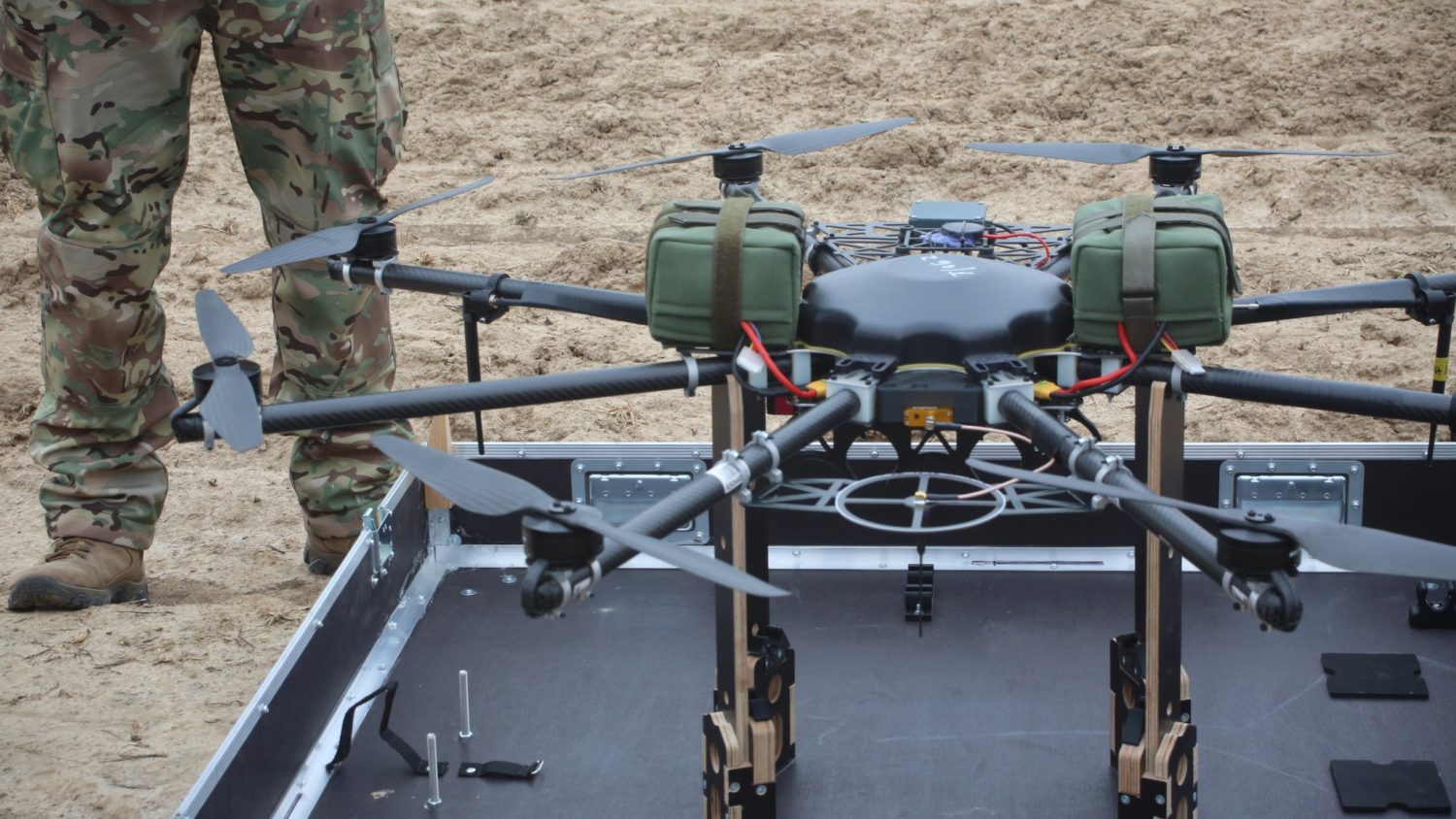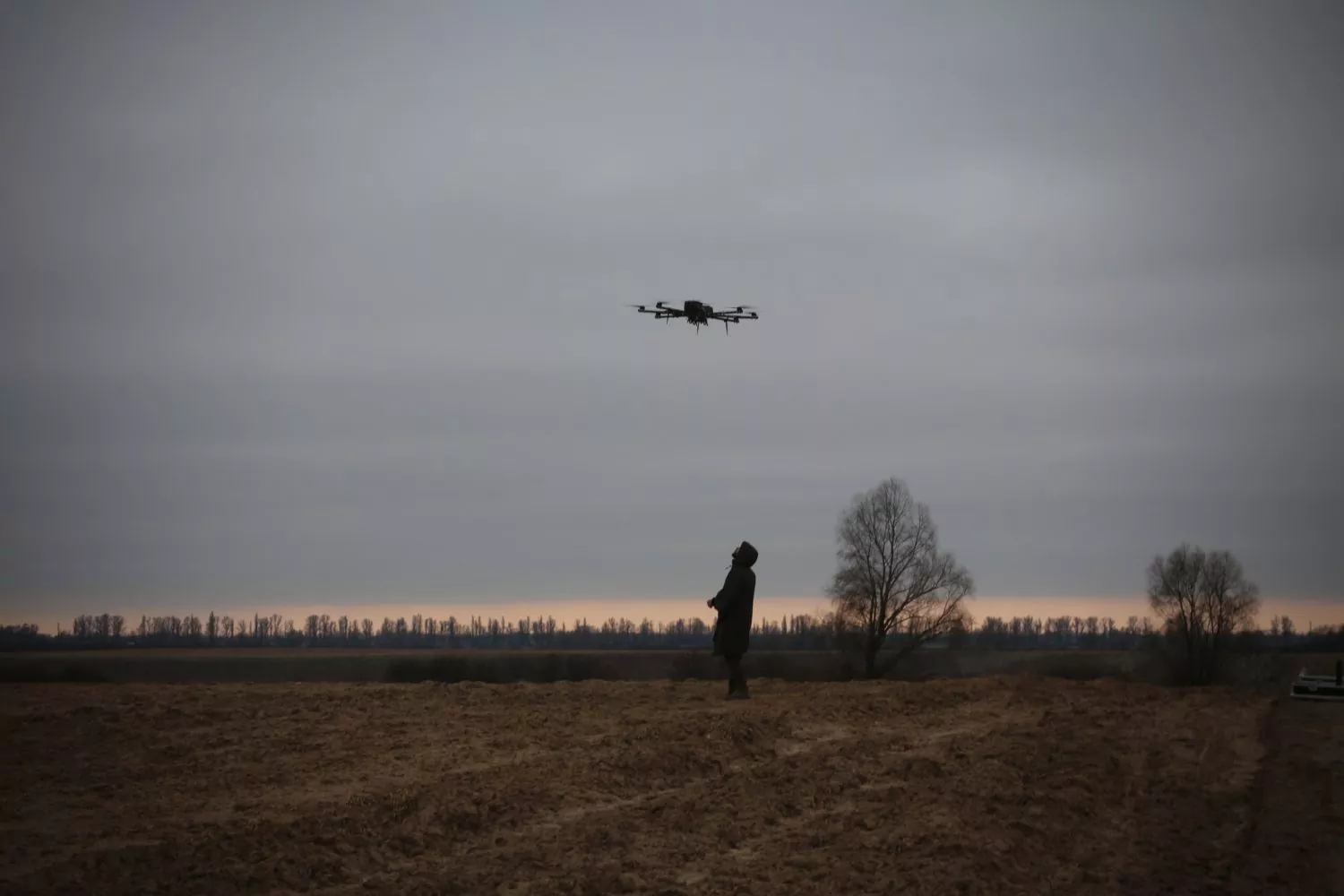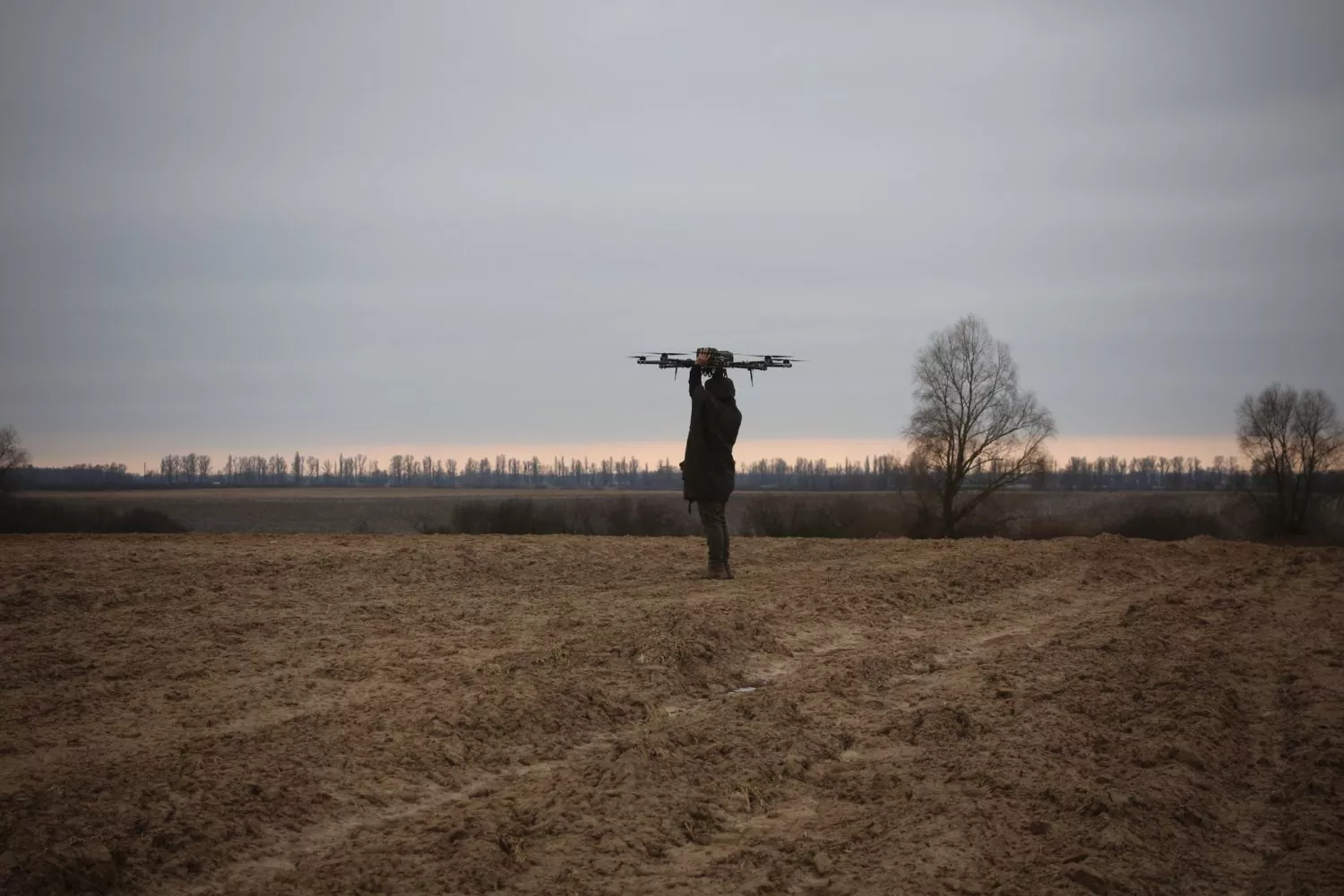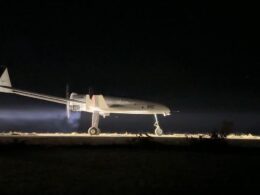A Ukrainian-made drone, the R18, has been transforming the battlefield in the country's fight against Russia’s aggression. Developed by Ukrainian NGO Aerorozvidka, the octocopter drone is equipped with a thermal imager and can carry and drop explosives on military equipment or other tactical targets. We met with Aerorozvidka instructors as they tested one of the R18 drones – a necessary procedure before it can be deployed to the front lines.
Since 2014, Ukrainian NGO Aerorozvidka (aerial reconnaissance), which is closely cooperating with the Armed Forces, has been playing a vital role in defending the nation against Russia’s aggression. This team is a prime example of civil society's direct engagement in resisting foreign aggression. In 2022, it played a decisive role in a battle near Kyiv and continues to be crucial in Ukraine’s national resistance to Russia’s aggression.
Aerorozvidka, which has hundreds of active members, specializes in drone development and improvement, using customized and weaponized drones to inflict significant losses on the Russian military. Aerorozvidka instructors improve the skills of drone operator crews, while the technical team constantly upgrades the drones. Before being sent to the front lines, each drone is thoroughly tested on a training ground to eliminate any potential issues.
On one of the training grounds, we met with Aerorozvidka instructor Serhiy Ristenko, together with Aerorozvidka's team, while they were testing the R18 drone — a cost-effective and devastating weapon that has inflicted enormous damage on Russian military equipment.

Ukraine's R18: game-changing night drone shaping the front lines
The R18 has been in use since 2018-2019, before Russia’s full-scale invasion of Ukraine in February 2022, and has already established a reputation for its capabilities. Designed for night operations to avoid being an easy target, during daylight hours it serves as a strike weapon. The R18 carries and drops bombs on military equipment and other strategic targets.
Typical tactics involve electronic warfare systems for reconnaissance and intelligence gathering, before deploying the R18 for a direct attack. Currently, the drone is being used across the entire front line, playing a critical role in the ongoing war.
“This is a fully Ukrainian-developed drone, which is impressive in comparison to other drone bombers made from repurposed agricultural drones. Our developers created this drone from scratch. Of course, some of the spare parts come from known sources [e.g., China.] However, the overall design is our own, making it highly convenient, especially because of the dynamic nature of the current war and the opportunities for constant improvements,” says Ristenko.
Developed by Ukraine's Aerorozvidka organization, the R18 octocopter is equipped with a thermal imager and can fly up to 13 km when carrying explosives.
Aerorozvidka asserts that for every dollar spent on these drones, the Russian army incurs $670 in losses.
The Ukrainian military participated in the development of the R18 UAV, beginning in 2017. The drone started engaging enemies on the front lines in 2019.
Following Russia's 2022 invasion, the UAVs were first utilized at Hostomel airport in the Bucha Raion. The complex includes two drones -- so that if one is destroyed, the other can be used to complete the mission.
The R18 is resistant to enemy electronic warfare, features a thermal imaging camera for night operations, and employs RKG-3 anti-tank grenades or RKG-1600 bombs for attacks. It can also function as a transport drone, and has transported ammunition and medicine to surrounded units.
Producing multiple state-of-the-art R18 drones daily at its factory, Aerorozvidka has been highly effective against Russian invaders, marking a significant upgrade from the commercial drones previously used by Ukrainian forces.
The drone is only supplied after extensive testing. However, encountering issues during testing in a controlled environment — like a training field — cannot be replicated to live action in the field.
When a drone is carrying ordnance, and malfunctions during combat, the ramifications are entirely different. Once, a drone's strap supporting a grenade snapped and fell a mere 20 meters from the operators – causing a potential disaster for Ukrainian troops.
“Therefore, it is crucial to inspect and test everything as rigorously as possible, to guarantee reliability
,” says Ristenko.
Decisive aerial strikes: R18 drones in action during the Kyiv offensive
He wanted to use his skills where they would be most effective. “Of course, I could become a driver, but this is like using a cell phone to hammer nails.”
With non-military drone flights now strictly prohibited in Ukraine, many photographers and other users who previously flew drones have been left with equipment they cannot use. Ristenko is able to use these drones to put his skills to good use. Aerorozvidka flies drones on a near-daily basis, and in this fundamental way Ristenko contributes to the ongoing defense of his country.
Near Kyiv, several crews operate simultaneously, working tirelessly in a continuous cycle, targeting and destroying any enemy movement they spot. Many targets along the strategic Zhytomyr trail have been hit by R18 drones. Targets include tanks, infantry fighting vehicles, armored personnel carriers, and other military vehicles like Urals.
The R18 drone is often used for strategic planning rather than impromptu attacks, although these do occur as well. During the Kyiv offensive, in February and March 2022, the situation was changing rapidly, and numerous targets were engaged. The Russian forces moved in long, multi-kilometer columns, creating many opportunities for R18s to strike.
Outsmarting the enemy: how Ukrainian engineers keep drones one step ahead in an intense and evolving war
Ristenko emphasizes that comparing this war to other drone wars in places like Afghanistan, where US Navy SEALs encountered much less electronic warfare, is not possible. The absence of these countermeasures made it easier to carry out missions.
In contrast, the current Russo-Ukrainian war is more intense, since the use of electronic countermeasures makes it difficult to operate, and necessitates frequent changes in tactics to adapt to ever-evolving conditions.

The Russians are not to be underestimated, since they learn quickly and adapt their tactics. For example, the tactics used in the summer of 2022 are no longer effective, because the Russians have developed new countermeasures. Both sides are constantly learning from each other, and the primary goal is to stay one or two steps ahead.
“One of the major advantages of having this drone developed in Ukraine is that we have a department of engineers here working on improvements,” says Ristenko.
Engineers analyze almost every case where drones are lost or destroyed. They identify how the Russians suffered the loss, and use the information to develop new countermeasures that prove effective in combat.
“However, we understand that we have a limited amount of time because sooner or later, they will find a countermeasure to this. I know engineers who are already thinking about how [Russians will] counteract the drones that are flying now, and how to bypass the countermeasures that the Russians continue to develop. The engineers say that once a countermeasure is executed, the Russians will be using it within four months. By the time they are doing so, we must be able to bypass it.”
Ristenko tells us that on one occasion, an R18 was hit and badly damaged. One of its batteries malfunctioned and fell off, while two of its propeller blades were blasted by enemy troops. Despite this, the drone managed to fly back home.
Typically, the Mavic drone (used for reconnaissance) has four propeller blades with power distributed evenly among them – each blade with 25% of the total power. However, the R18 has eight blades, each blade with about 12% of the total power. This means that even if one or two blades are damaged, the drone can still return safely.

“Our task is to minimize the risks to personnel and cause as much damage [to Russian troops] as possible. Thus, our perfect offensive is carried out almost without any personnel.”
To achieve a successful strike, the drone crew must have a proper understanding of the algorithms required to pinpoint the exact position to destroy the target. Training is crucial to master these skills.
Training focuses on experienced individuals as well as those with excellent flight and strike experience. It is done in small groups of three to four crews, each consisting of a pilot, navigator, and saper. The instructors don't share the conveyor-belt approach, preferring to deal with a few professional teams instead of multiple amateur ones. “It’s better to have one team of professionals than 45 teams of semi-professionals,” says Ristenko.
From garage cooperatives to a drone nation: Ukraine’s push to lead the future of aerial technology
While dozens of Ukrainian-developed drones – of various models – already exist, Ristenko says grassroots competition is ongoing “between garage cooperatives and aviation modeling clubs.”
“It’s very good when there’s such a push and everything is progressing all the time. At the beginning of the full-scale war, few people thought there would be so many drones. But it's been a year, and now there are a lot of Ukrainian strike wing kamikaze drones.”
Aerorozvidka exchanges experience with other grassroots teams developing drones. In a recent exchange, Ristenko tried operating kamikaze drones developed by Aerorozvidka’s tactical group Ptakhy Madiara (Madiar’s Birds), and came away knowing that Ukraine’s kamikaze drones also have a bright future ahead.
“I understand that after the war, we will be one of the most powerful ‘drone nations’ in the world. Because even grandpas in villages know how to control drones. It’s nationwide. It’s as if a child who has just learned to eat with a spoon is immediately taught to operate a drone,” says Ristenko, smiling.
Related:
- Ukraine finally launches domestic ammunition production. How will this impact the war?
- Ukraine trains 10000 drone pilots within "Army of drones" project
- “We joke that if a leg is amputated below the knee it doesn’t count.” Soldiers get advanced prosthetics in Ukraine
- The Novovolynsk miracle: how Russia’s invasion turned a Ukrainian mining town into an uber-volunteer hub
- Businesses fleeing war to west Ukraine find a new life and help the army
- Ukrainian theology professor turned sniper tells how to hunt for Russian invaders
- Whoever could, fled the Russians. They went back to Irpin to save the rest
- “The route to life.” How volunteers secretly rescued 75,000 from a city encircled by Russian troops





